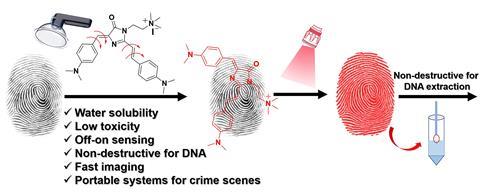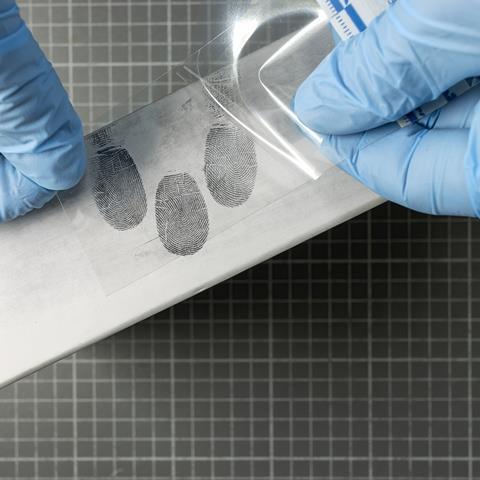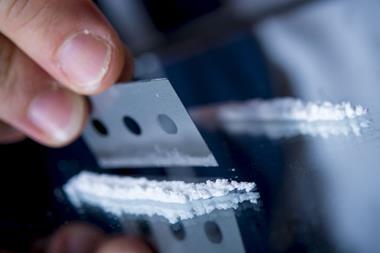A new class of fluorescent dyes can instantly visualise hidden fingerprints at crime scenes. Compared with traditional chemical reagents used for detecting latent fingerprints, the fluorescent dyes are quick, easy-to-use on site and non-toxic.
‘If the quality of the fingermarks is consistently good, having such an easy technique that would work in just 10 seconds is an interesting option,’ says Fabio Casali, a forensic scientist at the University of Strathclyde who was not involved in the study. ‘Comparing this methodology with ninhydrin, it is easy to see the huge potential benefits of the new technique: extremely rapid enhancement, no need for ovens or control of temperature and humidity, and much easier application directly at the crime scene.’

Fingerprint identification in crime scene investigation has been standard practice since the late 19th century. While various chemical reagents are commonly used to reveal fingerprints, existing formulations often require organic solvents that are harmful in large doses and may compromise the integrity of any DNA in the print. Other, more advanced techniques, such as fluorescent carbon dots and nanoparticles, have been effective but require expensive, often toxic heavy metals and have relatively long visualisation times that require analysis off site.
‘Rapid, on-site fingerprint identification can greatly improve the efficiency of crime scene investigation,’ explains study author Chusen Huang of Shanghai Normal University. ‘A solution of the dyes can then be easily sprayed … and the patterns of the [fingerprints] obtained in 10 seconds using our portable system.’
The dyes are called LFP-Yellow and LFP-Red and are derived from green fluorescent protein (GFP), first isolated from jellyfish. GFP fluoresces under UV light and, as it’s soluble in water and compatible with biological systems, has been used extensively to study the behaviour of proteins.

Huang and his collaborators hypothesised that positively charged nitrogen atoms within the LFP-Yellow and LFP-Red molecules would interact selectively with constituents of latent fingerprints, locking the molecules in place. ‘The probes are only weakly fluorescent in aqueous solution, but emit strong fluorescence once they bind to the [latent fingerprints] through the interaction between the probes and fatty acids or amino acids,’ explains co-author Tony James at the University of Bath. ‘Thus, the … patterns [are] selectively visualised and captured.’
The team designed a portable ultrasonic nebuliser to release a fine mist, preventing the destruction of any prints from possible splashes typical when using a normal spray bottle. They then developed a photographic system consisting of a light to illuminate the dyes and a smartphone to capture the fingerprints.
The system’s ability to selectively detect fingerprints was tested on a range of surfaces, including ceramics, steel, plastic, glass, tinfoil and acrylic. After the substrates were sprayed with a dye solution for 10 seconds, a clear and high-contrast fingerprint was observed in each case.

‘The study is significant as [the dyes] appear to have an affinity for components of latent fingerprints,’ says Marcel de Puit at TU Delft. However, he says comparing how conventional fingerprinting tools compare with the new technique will require a side-by-side analysis to be able to make any substantial claims.
Casali agrees, adding that uptake in the field may be slow. ‘Forensic science tends to be a bit conservative when it comes to new technology and its implementation in casework,’ he says. ‘Techniques need to be extensively studied, validated, accredited and accepted by the courts. Inevitably, these processes take time.’


















No comments yet